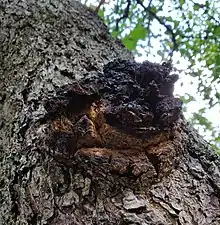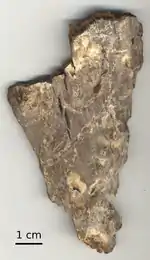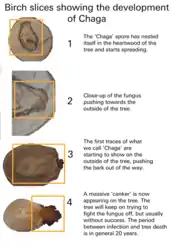Inonotus obliquus
Inonotus obliquus, commonly known as chaga (a Latinisation of the Russian word чага), is a fungus in the family Hymenochaetaceae. It is parasitic on birch and other trees. The sterile conk is irregularly formed and has the appearance of burnt charcoal. It is not the fruiting body of the fungus, but a sclerotium or mass of mycelium, mostly black because of the presence of massive amounts of melanin.[2] Some people consider chaga to be medicinal.[3]
| Inonotus obliquus | |
|---|---|
 | |
| Scientific classification | |
| Kingdom: | |
| Division: | |
| Class: | |
| Order: | |
| Family: | |
| Genus: | |
| Species: | I. obliquus |
| Binomial name | |
| Inonotus obliquus | |
| Synonyms[1] | |
|
Boletus obliquus Ach. ex Pers. (1801) | |
| Inonotus Obliquus | |
|---|---|
float | |
| smooth hymenium | |
| no distinct cap | |
| hymenium attachment is not applicable | |
| lacks a stipe | |
| ecology is parasitic | |
| edibility: not recommended | |
I. obliquus is found most commonly in the Circumboreal Region of the Northern Hemisphere, where it is distributed in birch forests.[4]
Morphology




I. obliquus causes a white heart rot to develop in the host tree. The chaga spores enter the tree through wounds, particularly poorly healed branch stubs. The white rot decay will spread throughout the heartwood of the host. During the infection cycle, penetration of the sapwood occurs only around the sterile exterior mycelium mass.[4] The chaga fungus will continue to cause decay within the living tree for 10–80+ years. While the tree is alive, only sterile mycelial masses are produced (the black exterior conk). The sexual stage begins after the tree, or some portion of the tree, is killed by the infection. I. obliquus will begin to produce fertile fruiting bodies underneath the bark. These bodies begin as a whitish mass that turn to brown with time. Since the sexual stage occurs almost entirely under the bark, the fruiting body is rarely seen.[5] These fruiting bodies produce basidiospores which will spread the infection to other vulnerable trees.
Common names
The name chaga (/ˈtʃɑːɡə/ ) comes from the Russian name of the fungus (transliterated from чага), which in turn is purportedly derived from the word for the fungus in Komi-Permyak, the language of the indigenous peoples in the Kama River Basin, west of the Ural Mountains. It is also known as the clinker polypore (from its resemblance to the slag left after a coal fire, known commonly as "clinker" when coal fires were common), cinder conk, black mass and birch canker polypore.[6] In England and officially in Canada, it is known as the sterile conk trunk rot of birch.[7]
Distribution and cultivation
Generally found growing on birch (Betula spp.) trees, it has also been found on alder (Alnus spp.), beech (Fagus spp.), oak (Quercus spp.) and poplar (Populus spp.).[8] In species other than birch, the fungus often appears as buried stem canker, instead of the charcoal-like mass found on birch trees.
Attempts at cultivating this fungus on potato dextrose agar and other simulated mediums resulted in a reduced and markedly different production of metabolites.[9][10] Cultivated chaga developed a reduced number of phytosterols, particularly lanosterol, an intermediate in the synthesis of ergosterol and lanostane-type triterpenes.[9]
Chemistry
The black sclerotium has been shown to contain large concentrations of melanin.[11][12] Chaga has been reported to contain extremely high concentrations of oxalate, 2800–11200 mg total oxalates/100 g sclerotium, one of the highest reported levels of any organism.[13]
Preparation
Chaga is traditionally grated into a fine powder and used to brew a beverage resembling coffee or tea. However, caution is warranted with chronic use due to the extremely high concentrations of oxalates in chaga. Currently, three extraction processes are used.
- Hot water extraction is one of the most common preparations. A decoction is created by simmering pieces of the chaga in numerous quarts of water until the water is reduced and the remaining liquid contains a portion of the chaga's concentrated water-soluble compounds. Such preparations, produced in China and Japan, are exported worldwide. The ß-D-glucans may have a content of approximately 35% in a pure extract.[14] If chaga tea is prepared at home, the chaga chunks can be reused multiple times.
- Ethanol or methanol extraction isolates the water-insoluble components, betulinic acid, betulin and the phytosterols. This extraction process is in general used as a second step after hot-water extraction, since ethanol alone will not break down chitin effectively—heat is essential.
- Fermentation is the most time-consuming and most expensive. Because fermentation methods are not standardized (many types of bacteria and fungi can be used in the process), the outcome is also not standardized.
See also
References
- "Inonotus obliquus (Ach. ex Pers.) Pilát 1942". MycoBank. International Mycological Association. Retrieved 11 October 2011.
- Babitskaya, VG; Shcherba, VV; Lkonnikova, NV (2000). "Melanin complex of the fungus Inonotus obliquus". Appl Biochem Microbiol. 36 (4): 377–381. doi:10.1007/BF02738046. S2CID 46047121.
- Meuninck, Jim (2017). Foraging Mushrooms Oregon: Finding, Identifying, and Preparing Edible Wild Mushrooms. Falcon Guides. p. 111. ISBN 978-1-4930-2669-2.
- Lee, Min-Woong; Hur, Hyeon; Chang, Kwang-Choon; Lee, Tae-Soo; Ka, Kang-Hyeon; Jankovsky, L. (December 2008). "Introduction to Distribution and Ecology of Sterile Conks of Inonotus obliquus". Mycobiology. 36 (4): 199–202. doi:10.4489/MYCO.2008.36.4.199. ISSN 1229-8093. PMC 3755195. PMID 23997626.
- MushroomExpert.Com. "Inonotus obliquus (MushroomExpert.Com)". www.mushroomexpert.com. Retrieved 15 August 2017.
- Needham, Arthur (16 December 2005). "Clinker Polypore, Chaga". Archived from the original on 9 September 2011. Retrieved 10 October 2011.
- "Sterile conk trunk rot of birch". Canadian Forest Service, Natural Resources Canada, Government of Canada. 4 August 2015. Retrieved 15 August 2017.
- Ryvarden L, Gilbertson RL (1993). European polypores. Part 1. Oslo: Fungiflora-Fungiflora. pp. 1–387.
- Zheng, W. F.; Liu, T.; Xiang, X. Y.; Gu, Q. (July 2007). "Sterol composition in field-grown and cultured mycelia of Inonotus obliquus". Yao Xue Xue Bao = Acta Pharmaceutica Sinica. 42 (7): 750–756. PMID 17882960.
- Zheng W, Miao K, Liu Y, Zhao Y, Zhang M, Pan S, et al. (2010). "Chemical diversity of biologically active metabolites in the sclerotia of Inonotus obliquus and submerged culture strategies for up-regulating their production". Applied Microbiology and Biotechnology. 87 (4): 1237–54. doi:10.1007/s00253-010-2682-4. PMID 20532760. S2CID 22145043.
- Babitskaya, VG; Shcherba, VV; Lkonnikova, NV; Bisko, NA; Mitropolskaya, NY (2002). "Melanin complex from medicinal mushroom Inonotus obliquus (Pers: Fr) Pilát (chaga) (Aphyllophoromyceditdeae)". Int J Med Mushrooms. 4: 139–145.
- Lee, JH; Hyun, CK (September 2014). "Insulin-sensitizing and beneficial lipid-metabolic effects of the water-soluble melanin complex extracted from Inonotus obliquus". Phytother Res. 28 (9): 1320–1328. doi:10.1002/ptr.5131. PMID 24615848.
- Kikuchi, Y; Seta, K; Y, Ogawa; et al. (June 2014). "Chaga mushroom-induced oxalate nephropathy". Clin Nephrol. 81 (6): 440–444. doi:10.5414/CN107655. PMID 23149251.
- Rhee, S.Y. (2008). "A comparative study of analytical methods for alkali-soluble β-glucan in medicinal mushroom, Chaga (Inonotus obliquus)". LWT - Food Science and Technology. 41 (3): 545–549. doi:10.1016/j.lwt.2007.03.028.